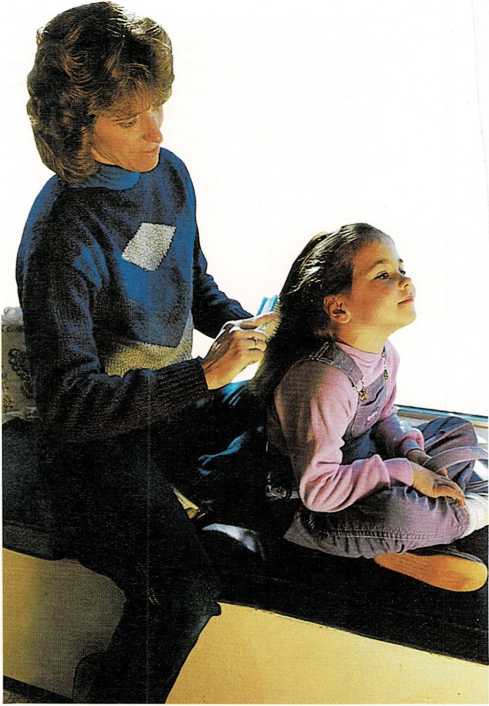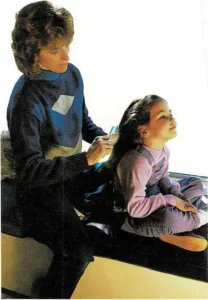Hair Care – Heart Murmur
Hair care. The color of your child’s hair, its texture, and its
abundance are physical characteristics for which you and the child’s
ancestors are responsible. But its luster, vitality, and attractiveness
depends mostly on the child’s general health and on the kind of hair and
scalp care the child receives.
Your child’s hair needs a daily brushing of at least 100 strokes to give
it gloss, to remove loose scales, and to stimulate the scalp. Boys with
short hair require less brushing. Begin brushing the child’s hair
regularly as soon as there is enough hair to brush. Be sure to use a
brush with soft bristles that will not scratch or irritate the tender
scalp. Separate the hair into sections and brush up and away from the
scalp, one section at a time. Move your wrist with each stroke so that
the brush goes through a rolling motion.
If you use a comb, pick one with blunt teeth, because sharp edges may
injure the scalp and hair. Take a small section of tangled hair and
start combing it about two inches from the free end of the hair. When
the comb passes freely to the end, place it a little higher in the
section and comb through to the end again. Repeat the procedure until
the comb passes freely from the scalp to the end of the hair.
Combs and brushes are as individual as toothbrushes. Each child should
have his or her own. Wash combs and brushes frequently in warm soapy
water to keep them clean and fresh.
If your child’s hair is brushed and combed each day, a shampoo once a
week or every

A good brushing is important for healthy, shiny hair. Use a soft
brush and brush up from the scalp with a rolling motion. If hair is
tangled, brush the ends first and work upward.
ten days is probably enough. Use only gentle shampoos. Until puberty,
most children do not have much oil in their hair, and strong shampoos
may irritate the scalp and make the hair unmanageable. And if some
lather runs into a child’s eyes, a strong shampoo will burn or sting
much more than a specially prepared gentle one.
Brisk towel drying may break and split a child’s hair, so blot the hair
dry. A cream rinse may help your daughter if her hair snarls and tangles
after shampooing. If she has long hair, avoid styles such as tight pony
tails that pull excessively on the hair.
As adolescence approaches, your child may develop dandruff—small,
whitish scales that
form on the scalp and then flake off. Simple dandruff, with or without
mild itching, is not regarded as a scalp disease. A shampoo once a week
usually controls dandruff. If dandruff is excessive, uncontrollable, and
accompanied by itching and inflammation of the scalp, consult a doctor.
Children should be encouraged to take care of their own hair as soon as
they are willing to do so. Girls, especially, benefit from learning to
care for and arrange their own hair. Children should also be
complimented on their hair care. Compliments will further encourage
children to do a good job. M.G.
Hard of hearing. See Deafness
Hay fever (seasonal allergic rhinitis) is an allergic reaction of
the nose and eyes caused by pollen, molds, and other substances floating
in the air. Common symptoms include sneezing; stuffiness; difficult
nasal breathing; runny nose and eyes; and itching of the eyes, nose,
ears, and the roof of the mouth. A fever is not one of the symptoms.
Some children who have hay fever also develop asthma.
Hay fever occurs at certain times of the year and is usually caused by
pollens from gi\’ass, trees, ragweed, and related weeds, or by airborne
molds.
If typical hay fever symptoms last all year, your child may have
perennial allergic rhinitis. Substances in the air other than pollen,
such as dust and animal dander (particles from skin, hair, and feathers)
are some of the substances that cause perennial allergic rhinitis. If
your child seems to have a constant cold, the child may be allergic to
something.
If you think your child has either seasonal or perennial allergic
rhinitis, consult the doctor. The doctor may recommend sending the child
to an allergist (a doctor specializing in the treatment of allergies).
The allergist will probably perform tests to determine what substances
(called allergens) are causing the reaction. Once the allergens are
identified, you may be able to eliminate them from the child’s
surroundings, or at

The pollen from ragweed causes hay fever in many children. One
ragweed plant can produce a billion pollen grains.
least reduce them. Sometimes the allergist can immunize the child
against the allergens. The allergist may also prescribe drugs to relieve
symptoms.
The allergist may suggest that you do several things:
Eliminate stuffed toys, wall-to-wall carpeting, upholstered
furniture, and feather pillows from the child’s room—possibly from
the entire home.Encase the child’s mattress and box spring in an allergen-proof
cover to reduce dust.Keep windows closed to minimize entry of pollen.
Use an air conditioner with a good filter or an air-cleaning device
to clean the air, and keep the humidity low.Avoid smoking in the home or car.
Keep no pets that have either fur or feathers. J.S.H.
See also Allergy; Asthma
Head injuries are fairly common among children, but relatively few
are serious. However, if your child loses consciousness— either at the
time of a head injury or later— call a doctor immediately. Any blow
that knocks the child unconscious could cause brain injury from bleeding
inside the skull.
A child who has a severe bump on the head should be kept quiet for a
while and watched closely for these danger signs: ■ Severe headache.
Persistent vomiting. If the child vomits more than once or twice
after a head injury, call the doctor.Difficulty in speaking. If the child’s speech is slurred or if the
child is not able to talk as well as usual, call the doctor.Unequal pupils. If the pupils of the child’s eyes are not the same
size, call the doctor. ■ Double vision. If your child complains of
double vision, or if you notice that the child squints one eye to
prevent seeing double images, call the doctor.
* Weakness of one side. If the child is unsteady in walking, or limps,
call the doctor. If the child cannot use one arm or leg as well as the
other, call the doctor.
Excessive sleepiness. The child may go to sleep after a head injury.
If you cannot awaken the child easily, call the doctor.Convulsions. If convulsions start, turn the child’s head to one side
so that vomit can run out. Call a doctor as soon as possible.
If the child shows none of these symptoms for 12 hours after a head
injury, the child is probably all right. In some cases, intermittent
headaches can persist up to a few weeks as a result of a head injury. In
rare cases, persistent headache, drowsiness, and a change in the child’s
normal behavior may develop days or weeks after a head injury because of
a slowly accumulating blood clot. If any of these symptoms do appear,
call the doctor immediately.
See also Coma; Convulsions; Fever
Headaches can usually be relieved by pain medicine in doses
appropriate for the child’s age. If your child has a headache that does
not respond to acetaminophen, call the doctor. Headaches have many
causes: ■ A child with a sudden infection and fever may develop a
headache. The headache usually subsides as the infection clears up.
Fatigue and overexposure to sun can cause headaches.
Emotional tension can cause persistent or recurrent headaches in
children.Eyestrain can also cause recurring headaches. If headaches occur
frequently, have your child’s vision checked.
A few children have quite severe headaches called migraines. A child
with a mi- graine may see spots before the eyes, become nauseated, and
even vomit. Unusual excitement, nervous strain, emotional upset, or
excessive fatigue may cause migraines. The child may feel better lying
down in a quiet, darkened room. A doctor can prescribe medicine for
migraine headaches, [m.g.]
Hearing aid. See Deafness
Heart murmur is an unusual sound produced by an abnormal flow of
blood through the chambers of the heart. A normal heart makes “lub-dub,”
“lub-dub” sounds every time it beats. The “lub” sound occurs when two
valves inside the heart close. The “dub” sound is made when the valves
in the aorta
and the pulmonary artery close. A heart murmur is a rumbling or scratchy
noise.
A very common group of heart murmurs is called functional or innocent
murmurs. These murmurs are completely harmless and tend to disappear
when the child reaches adolescence.
Other murmurs are caused by abnormal blood currents flowing through
channels narrowed by disease, through defective channels present at
birth, or through holes in walls within the heart.
Usually, heart murmurs are discovered during a doctor’s examination.
Most heart murmurs are harmless and do not interfere with the child’s
normal life. [m.g.]

